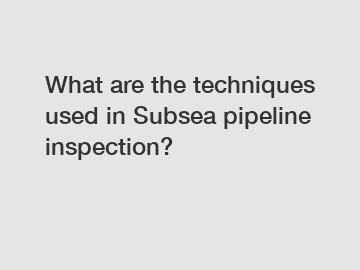What are the techniques used in Subsea pipeline inspection?
When it comes to ensuring the safety and integrity of subsea pipelines, regular inspection is crucial. Subsea pipeline inspection involves the use of various techniques to assess the condition of the pipelines and identify any potential issues. In this article, we will discuss some of the common techniques used in subsea pipeline inspection.
Visual Inspection.
Visual inspection is one of the simplest and most commonly used techniques for subsea pipeline inspection. In this method, specially designed cameras are used to capture images of the pipeline's surface. These images are then analyzed to identify any signs of corrosion, cracks, or other damage. Visual inspection can provide valuable information about the overall condition of the pipeline and help to identify areas that may require further inspection.

Ultrasonic Testing.
Ultrasonic testing is another commonly used technique for subsea pipeline inspection. In this method, high-frequency sound waves are used to detect defects in the pipeline's wall thickness. By measuring the time it takes for the sound waves to travel through the pipeline and bounce back, technicians can assess the thickness of the pipeline wall and identify any areas of corrosion or thinning.
Magnetic Particle Testing.
Magnetic particle testing is a non-destructive testing method used to detect surface and near-surface flaws in subsea pipelines. In this technique, magnetic particles are applied to the pipeline's surface, and a magnetic field is used to attract the particles to any areas of discontinuity or defects. By inspecting the distribution of the particles, technicians can identify areas of concern and assess the overall condition of the pipeline.
Eddy Current Testing.
Eddy current testing is another non-destructive testing method used in subsea pipeline inspection. In this technique, an alternating current is passed through a coil, creating a magnetic field around the pipeline. Any changes in the magnetic field caused by defects or damage in the pipeline can be detected and analyzed. Eddy current testing is particularly useful for detecting corrosion, cracks, and other types of surface damage in subsea pipelines.
In-Line Inspection Tools.
In addition to these techniques, in-line inspection tools, also known as "pigs," are commonly used for subsea pipeline inspection. These specialized devices are inserted into the pipeline and travel along its length, collecting data on the condition of the pipeline as they move. In-line inspection tools can provide detailed information on the thickness of the pipeline wall, the presence of defects, and other important parameters.
In conclusion, subsea pipeline inspection involves the use of various techniques to assess the condition of the pipelines and ensure their safety and integrity. Visual inspection, ultrasonic testing, magnetic particle testing, eddy current testing, and in-line inspection tools are some of the common techniques used for this purpose. By employing these techniques, pipeline operators can identify and address any potential issues before they escalate into serious problems. If you have any questions about subsea pipeline inspection or would like to learn more about the techniques used, you can contact us for more information. We are a leading supplier of subsea inspection equipment and can provide you with the tools and expertise you need to ensure the safety of your pipelines.
If you want to learn more, please visit our website N2 He Leak Testing, China Pipe Flushing Service, Offshore Pipeline Inspection Company from China.
102
0
0


Comments
All Comments (0)